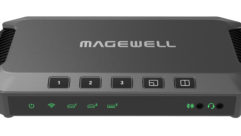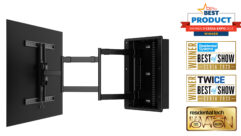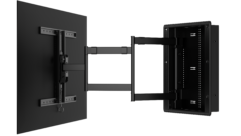
Technology Showcase: Videoconferencing Systems
Apr 1, 2008 12:00 PM,
By Jay Ankeney
Long-predicted communications technology fulfills its potential.

Sony PCS-XG80
Rarely has any technology revolution been so eagerly awaited and long predicted as the videoconferencing systems that are emerging into corporate, medical, and educational scenes today. As long ago as Fritz Lang’s 1927 silent classic Metropolis, the corporate executives of the Upper World conversed through video screens — even though the reality of Flapperera television was still in its fuzzy, gray infancy. When video communications did become feasible in the ’30s and ’40s, the concept of closed-video communications was hatched first as closed-circuit TV (CCTV). The earliest recorded CCTV installation was designed by German engineer Walter Bruch in 1942 using a 441-line system and installed by Siemens AG at Test Stand VII in Peenemünde to monitor the launch of V-2 missiles. Primitive by today’s standards, it was considered high definition compared to the Baird or Farnsworth televideo systems of the time. The concept would wait more than half a century to become practical.
The paradigm switch from one-way watching to two-way AV interaction began to take shape at the 1964 New York World’s Fair, when AT&T introduced its Picturephone in a desktop cabinet. By the 1967 Montreal Expo, it had become the Videophone, equipped with a Plumbicon camera and a small CRT receiving 200 scan lines over a 1MHz bandwidth. By 1970, Picturephone booths were set up in Grand Central Station and in the Pittsburgh offices of Westinghouse, along with other forward-looking companies. But the technology proved more Buck Rogers than Daddy Warbucks, and the service died by 1974. A Sept. 6, 2001, report on CNN said the Picturephone service only had 500 subscribers at its peak.
There have been several other attempts to find a market for closed-AV communication systems, but for most, the verdict was that a sour apple is worse than no apple at all. By the 1980s, the advent of circuit-switched ISDN lines could ensure a minimum bit rate of 128kbps, and brave firms such as PictureTel (later purchased by Polycom) used highly proprietary equipment to market the idea, but it experienced limited success. By the 1990s, the rise of Internet Protocol (IP) brought with it free services such as NetMeeting, MSN Messenger, Yahoo Messenger, and Skype. Although the public enjoyed the novelty, the quality of these services was so low that corporations could not rely on that form of videoconferencing — which was by then referred to most often as videoconferencing or video teleconferencing (VTC) — as a serious business tool.
But in the last few years, a perfect storm of converging technologies has brought videoconferencing onto the main stage of corporate communications. The popularity of high-definition consumer televisions brought the cost of HD displays to an affordable level for widespread corporate installation, but the label of “high definition” that is stuck onto many high-end VTC systems needs to be taken with a grain of salt. A large number of them have adopted the relatively bandwidth-efficient 720p format (16:9 widescreen with 1280×720 resolution), but they are sending it out with only 30 fields per second (720p/30) — or sometimes even less. That would not qualify as high definition in the broadcast sense, so the “/30” or “/60” indication of the field rate will be included here when it is available. On the other hand, there is a strong movement by several companies toward providing full-1080p image density, which is more image density than even the best network broadcaster can pump out today.
The videoconferencing experience has rapidly improved thanks to recent developments, such as the increased bandwidth of both the Internet and private networks to provide the transportation throughput, improved compression from codecs such as H.254, and most importantly, the fact that the International Telecommunications Union (ITU) has given the industry three umbrellas of standards for videoconferencing: H.320 for public switched telephone networks (PSTN), H.323 for transporting packet-based multimedia applications over LANs, and H.324 standard for transmission over audio telephony networks or POTS (plain old telephone service). With the advent of standards, not only have videoconferencing systems become more reliable, but thanks to bridging technologies, VTC systems from different manufacturers are even beginning to talk to one another.
Another growing initiative called “Session Initiation Protocol (SIP),” designed by Henning Schulzrinne and Mark Handley, has helped this much desired goal. SIP offers the promise of a common protocol for creating, modifying, and terminating voice- or video-call sessions with one or multiple participants. Thanks to these developments, the top videoconferencing companies have even developed a new buzz word — telepresence — to describe the highest-end VTC systems, but few can agree on exactly what it means.
The basic concept behind telepresence seems to be an experience that is so real, it makes the participants feel as though they are all in the same room. This depends on a combination of high-definition video representing life-sized images, multichannel sound, a controlled environment, managed connectivity, and directed perspectives from the “local end” (you) and “far end” (them). This includes a concept of gaze control to make the sight line of everyone’s image appear as if they were speaking directly to other participants instead of into the eye of a camera.
Technology Showcase: Videoconferencing Systems
Apr 1, 2008 12:00 PM,
By Jay Ankeney
Long-predicted communications technology fulfills its potential.

Cisco TelePresence 1000
To preserve the reality of a telepresence system, audio conversations that accompany the video images have to be free of the lag time that can sometimes be caused by slow encoders or delays in transmission. Human perception has a threshold of about a 200-millisecond delay before the latency of communication becomes recognized. In addition to lifelike images, low audio latency of less than 200 milliseconds is crucial to preserve the immersive experience that tele-presence promises.
Today, Wainhouse Research, a marketing statistics firm that tracks the videoconferencing industry, estimates in its Q4 2007 year-end report that revenues are increasing by 39 percent for the industry as a whole, powered by a sales boom of almost 30 percent per year. While it is hard to calculate the impact of the trendy desire to get on the bandwagon of a nifty new corporate-communications gimmick, many insiders also credit the increased difficulty and environmental impact of business travel as a major impetus for modern videoconferencing’s success. One VTC system provider’s website, Teleris, even provides a carbon-footprint calculator certified by The CarbonNeutral Company to quantify the amount of greenhouse gases that can be saved by videoconferencing.
Companies that don’t want to invest in their own videoconferencing system can rent videoconferencing rooms on an as-needed basis from FedEx Kinkos or Regus.
Although the videoconferencing industry is dominated by two giants, Polycom and Tandberg — who together represent two-thirds of sales — an accelerating number of players are bringing out increasingly intriguing designs of their own. These can range from webcams to desktop-video endpoints, and from roll-around carts to single-point camera installations. But the greatest potential for impact on the corporate world seems to be from multiparticipant, multipoint videoconferencing systems that approach telepresence capabilities. After all, it is hard to call a video chat between two people a conference no matter how pristine the images. Here is a look at some of the most interesting group-oriented videoconferencing systems available on the market today.
THE MARKET
Italian company Aethra is offering the Vega X7R at the forefront in its development of video-communication technology. Created for systems integrators, the new version X7R is designed for simple insertion into professional rackmount installations. The integrated Multipoint Conferencing Unit (MCU) in the Vega X7R connects up to nine sites in mixed mode (ISDN, IP-H.323, and IP-SIP), with convenient dial-out and dial-in (Meet Me) configuration. The Vega X7R is optimized for 720p video on 16:9 screens at 768kbps, with the possibility to connect in HD at just 512kbps. The company intends to move to a 1080p HD capability in the future. The X7R works with the Aethra Maia XC videophone, combining professional videoconferencing features with IP telephony. The Aethra system is intended for use in professional conference rooms, auditoriums, and television studios, as well as for the creation of customized audio/video projects in high definition.
BrightCom ClearView conference room solutions are a series of integrated AV conferencing systems for small to large conference rooms using multiple screens. ClearView supports the most popular standards for compression, including H.264 for video and G.722 for audio. You can select the quality of video — from standard definition to HD — being used in the BrightCom ClearView conference room to conserve bandwidth for conference rooms with a slow connection. To prevent being blocked by a network’s security systems, ClearView is a completely proxy- and firewall-friendly tunneled video stream. In addition, the BrightCom Visual Collaborations System (VCS) is designed to be up and running in just a few minutes by using IP connectivity. Each server in the BrightCom Visual Collaborations system comes equipped with five meeting rooms, with each room holding up to 100 participants. Administrators can set the level of users within a meeting to maintain performance, depending on the network.
The Cisco Systems TelePresence systems are an attempt to live up to the promise of telepresence by making the whole room installation an extension of the videoconferencing experience. Cisco TelePresence is a comprehensive solution consisting of entire room systems containing up to three 65in. plasma screens; a high-definition, multipoint switching platform; multichannel spatial audio; Cisco TelePresence Manager software; and the lifecycle services to plan, deploy, and maintain the experience. Even a bit of stagecraft magic helps create the illusion of gathering at a table in the same room as the other people speaking, because the custom installation includes the same circular table in the far-side room as the table at which the participants in the local side are sitting. The Cisco TelePresence 1000 allows a small meeting for two per room or up to four at the virtual table. The Cisco TelePresence 3000 allows for six people per room, creating a seating environment for 12 participants.
With the largest patent base in the world on telepresence, DVE has become known for its dedication to cracking the control of eye contact in videoconferencing. The company solves the problem by putting the display in a floor cabinet, and directing it upward onto a semi-reflective sheet of glass mounted at 45 degrees to the viewer so it can act as a beam splitter. That way, a camera can be positioned behind the slanted glass and aimed directly at the viewer, but the viewer cannot see the camera. You can see this implementation in the DVE Telepresence 50, which is the company’s flagship product for group conferencing with two to eight people on a side.
Technology Showcase: Videoconferencing Systems
Apr 1, 2008 12:00 PM,
By Jay Ankeney
Long-predicted communications technology fulfills its potential.

Tandberg Experia videoconferencing system
DVE technology includes Intelligent Switched Telepresence, which empowers the DVE Telepresence 50 to cut automatically between cameras in a fashion similar to a broadcast production. For a more all-encompassing installation, the company also has a patented DVE Tele-Immersive Room, in which the imaged people can be seen sitting and standing in the physical room. The DVE Tele-Immersive Room even has a stereoscopic 3D visualization option, which can present volumetric 3D objects up to 9ft. wide floating in air. DVE recently formed a strategic alliance with Christie Digital Systems to assist in the integration of Christie’s Mirage HD 3D projectors — which are based on 1080p DLP technology — into the DVE systems.
Halo, with the Halo Video Exchange Network (HVEN), is HP‘s fully managed network of videoconferencing systems using 720p high-definition images on multiple screens. Halo is always available, so users can literally walk in the room and begin speaking, giving credence to HP’s slogan: “You’re not interacting with technology; you’re interacting with people.” Halo is the Cadillac of tele-presence systems, with installations costing up to $500,000 — but it doesn’t take many first-class tickets for traveling executives to run up that kind of bill.
Each Halo room includes four plasma-screen monitors and a high-definition 50in. collaboration screen for realtime data sharing. Users can access a high-magnification camera for sharing physical objects on the collaboration screen or plug a laptop into the in-room VGA connection to easily share documents and other information across both Halo locations. Halo’s Multipoint functionality features a patent-pending, three-axis-control operation camera system, which automatically adjusts to provide superior eye contact. HP also provides a Halo Concierge, who is available around the clock to answer questions and help make connections between companies.
Released last October, LifeSize Express is the newest videoconferencing model from LifeSize Communications, featuring 720p/30 images for inexpensive face-to-face collaboration. For multiuser meetings, LifeSize Conference is LifeSize’s telepresence system. It uses multiple displays and up to three HD PTZ cameras, and it integrates a wireless touchscreen control panel. It also offers embedded voice-activated switching and external audio, video, and data inputs and outputs. It is also standards-compliant, allowing the system to interoperate with nearly any videoconferencing system. The optional LifeSize SDI Adapter can extend the benefits of third-party HD videoconferencing cameras to the LifeSize Room.
The Polycom TPX HD Suite is interoperable with standards-based videoconferencing components and 60in. plasma screens to provide lifesize images of all remote participants. Referred to as a telepresence environment, the TPX HD Suite is a freestanding design with independent videowall and conference table. It can even be completely disassembled and moved to a new location. Managed Services provide all the interaction required, which increases the suite’s usability even for novice users of video-conferencing technology.
A key component is the HDX 9000 integrator’s codec, providing 720p/30 images connected to multiple HD-video sources. By the end of 2008, this should be upgraded to 1080p/30 quality. The Video Media Center (VMC) 1000 operates in tandem with the company’s Recording and Streaming Server (RSS) 2000 to link videoconferencing with video streaming. Audio is handled by the company’s SoundStructure C-series mixing system, which can have up to 16×16 inputs and outputs, and it boasts both monaural and stereo echo cancellation from 20Hz to 22kHz.
At the upcoming InfoComm show in June, Sony will be bringing out what it claims is the industry’s first 1080i high-definition videoconferencing system — the PCS-XG80. In the mind of broadcast veteran Sony, this is real HD because the images run at 60 fields per second. However, the backward compatibility of the PCS-XG80 will give users the option of connecting with HD-video quality through the growing number of high-bandwidth networks or through standard-definition legacy systems by complying with industry standards over IP and/or ISDN. Because it features six-site, multipoint conferencing, users of the PCS-XG80 will be able to call up to five other remote sites to simultaneously meet — and with multi-language support for up to 20 languages. From PowerPoint and animations to live DVD playback, users can also seamlessly share PC data in HD at 30fps. Dual-stream functionality lets users send two separate parallel streams of live HD information.
As the leader in providing both videoconferencing endpoints and infrastructure, Tandberg has experienced an enviable 33.5 percent annualized revenue growth for the past 10 years. In 2006, Tandberg was the first to introduce a high-definition desktop system: the Centric 1700. Today, the company’s Experia system offers a standards-based, across-the-table telepresence experience with single-touch controls and flexible installation options. With quad 50in. plasma screens, Tandberg’s precision HD cameras (720p/30) and directional, CD-quality spatial audio combine to provide a highly interactive forum for collaboration. The Experia system is an adaptive tele-presence approach that lets you join up to four sites for multipoint telepresence calls, with a dedicated collaboration monitor that allows participants to share PC presentations, DVDs, documents, and other peripheral devices. Experia also offers a high level of security with AES encryption and authentication.
The whole family of VirtuaLive HD videoconferencing systems from Teliris is the first telepresence system in the world to be certified by The CarbonNeutral Company, for those interested in quantifying the amount of carbon emissions videoconferencing can save by eliminating executive travel. Teliris’ VirtuaLive HD Unified system, using 720p/60 high-definition video, provides an environment in which every conference room matches so that the video side of the far table looks exactly like the in-person side of the local table.

Yamaha ProjectPhone PJP-300V
Last month, the company also launched its new VirtuaLive HD 360 system, which integrates the Teliris broadcast-quality telepresence offerings with a long list of collaboration tools — including whiteboarding, media editing, and product evaluation. The Teleris system delivers more than four simultaneous locations with its VirtualVectoring and VirtualDimensioning capabilities, which ensure the maximum level of eye contact between all videoconferencing participants. Because of local telecommunications cost issues, Teliris offers all of its products in SD format, which enables the implementation of VirtuaLive systems anywhere in the world.
Yamaha admits to being new to the videoconferencing game, having introduced its first stateside system at last year’s InfoComm. But starting with a blank slate has given the company a different slant on the idea of multicamera videoconferencing, and its background in audio has induced the company to emphasize sound communication. That’s why Yamaha’s unique ProjectPhone PJP-300V videoconferencing system has 16 arrayed microphones, each with automatic gain control geared for a 23ft. voice-pickup range. No mics are on the conference table; instead, the mics and the three 300-kilopixel CMOS cameras are all mounted in a sleek horizontal bar unit that can sit conveniently on top of a flatpanel display. The mics automatically track the person speaking and aim the proper camera at the source of his/her voice. It’s not exactly tele-presence, but Yamaha feels this fast-cut video approach delivers a TV-studio-like experience for the viewers. The PJP-300V can also be used as a standalone webconferencing systems by connecting it to a PC.
FOR MORE INFORMATION
Aethra
www.aethra.com
BrightCom
www.brightcom.com
The CarbonNeutral Company
www.carbonneutral.com
Cisco
www.cisco.com
FedEx Kinkos
www.fedex.com
LifeSize Communications
www.lifesize.com
Polycom
www.polycom.com
Regus
www.regus.com
Sony
www.sony.com/videoconferencing
Tandberg
www.tandberg.com
Teliris
www.teliris.com
Wainhouse Research
www.wainhouse.com
Yamaha
www.yamaha.com










